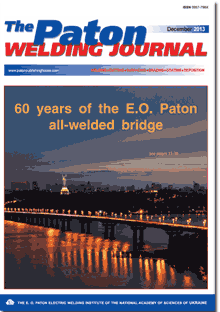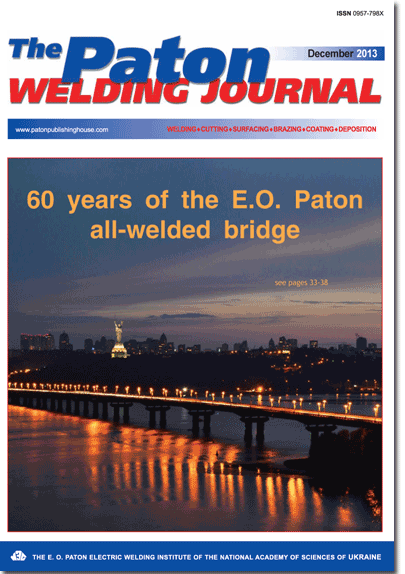Access for download PDF files for subscribers and for reviewers of scientometric bases.
Organization: Elsevier for content access(PDF files of journals released before 2024 are available for download from the website's archives))
Organization: Elsevier for content access(PDF files of journals released before 2024 are available for download from the website's archives))
| 2013 №12 (01) | 2013 №12 (03) |

The Paton Welding Journal, 2013, #12, 9-15 pages
STUDY OF EFFECT OF ELECTRIC ARC SPRAYING MODES ON STRUCTURE AND PROPERTIES OF PSEUDOALLOY COATINGS
Yu.S. BORISOV, N.V. VIGILYANSKAYA, I.A. DEMIANOV, A.P. GRISHCHENKO and A.P. MURASHOV
E.O. Paton Electric Welding Institute, NASU, Kiev, Ukraine. 11 Bozhenko Str., 03680, Kiev, Ukraine. E-mail: office@paton.kiev.ua
Abstract
A study of effect of electric arc spraying conditions on structure and properties of steel-copper pseudoalloy coating was performed. A method of multifactor experiment planning was used for determination of level of influence of spraying factors on coating characteristics. Analysis of splat specimens showed that the drops of metal are in a liquid state during collision with a basis at all studied modes of spraying. The regression equations were received which combine technological modes of spraying (rate of wire feed, voltage, consumption of compressed air, spraying distance) with hardness, content of steel and copper constituents, oxides and pores in the coating. It was determined that content of copper in total volume of the coating, obtained by spraying of steel and copper wires of similar diameter, depends on a heat input in spray consumable and makes around 35 vol.% at 0.6-1.0 MJ/kg and approximately 22 vol.% at 1.4-2.2MJ/kg. Possible reasons of reduction of copper content are the burn-out (evaporation) and oxidation of copper in spraying process due to its reheating above melting point. The most efficient method of reduction of copper loss due to its burning out during spraying of pseudoalloy steel-copper coating is decrease of level of heating of spray particles and increase of their speed due to rise of compressed air consumption and reduction of heat input in the spray consumable. The best complex of structure and properties of electric arc pseudoalloy steel-copper coatings based on indexes of preservation of component relation (1:1), porosity (8 vol.%), level of oxidation (21 vol.%) and hardness (2700 MPa) was received in the case of spraying with 1.0 MJ/kg heat input in the wire and 126 m3/h consumption of compressed air. 22 Ref., 2 Tables, 8 Figures.
Keywords: electric arc spraying, pseudoalloy coatings, microstructure, porosity, oxidation, microhardness
Received: 19.06.13
Published: 28.12.13
References
1. Korobov, Yu.S. (2006) Improvement of arc spraying technology on the base of modeling of interaction between metal and gases and study of coating properties: Syn. of Thesis for Dr. of Techn. Sci. Degree. UralGTU.
2. Vadivasov, D.G. (1956) Repair of parts by metal spraying. Saratov.
3. Krasnichenko, L.V. (1958) Modern technology of metal spraying. Moscow: Trudrezervizdat.
4. Brusilo, Yu.V. (2009) Specifics of coatings produced by electric metal spraying with posterior electrocontact sintering-up. In: Visnyk Nats. Transport. Univers. Pt1. Kiev: NTU, 75-82. Issue 19.
5. Pourmousa, A., Mostaghimi, J., Abedini, A. et al. (2005) Particle size distribution in a wire-arc spraying system. J. Thermal Spray Technology, 14, 502-510.
6. Borisov, Yu.S., Vigilanskaya, N.V., Demianov, I.A. et al. (2013) Investigation of dispersion of dissimilar wire materials during electric arc spraying. The Paton Welding J., 2, 24-30.
7. Newbery, A.P., Grant, P.S., Neiser, R.A. (2005) The velocity and temperature of steel droplets during electric arc spraying. Surface and Coatings Technology, 195, Issue 1, 91-101.
8. Ageev, V.A., Belashchenko, V.E., Feldman, I.E. et al. (1989) Analysis of methods for control of spraying particle parameters in electric arc spraying. Svarochn. Proizvodstvo, 12, 30-32.
9. Newbery, A.P., Grant, P.S. (2003) Large arc voltage fluctuations and droplet formation in electric arc spraying. Powder Met., 46(3), 229-235.
10. Liao, H.L., Zhu, Y.L., Bolo, R. et al. (2005) Size distribution of particles from individual wires and the effects of nozzle geometry in twin wire arc spraying. Surface and Coatings Technology, 200, Issue 7, 2133-2130.
11. Boronenkov, V.N., Korobov, Yu.S. (2012) Fundumantals of arc spraying. Physical-chemical principles. Ekaterinburg: UralGU.
12. Korobov, Yu.S., Boronenkov, V.N. (2003) Kinetics of interaction of spray metal with oxygen in electric arc metal spraying. Svarochn. Proizvodstvo, 7, 30-36.
13. Planche, M.P., Liao, H., Coddet, C. (2004) Relationships between in-flight particle characteristics and coating microstructure with a twin wire arc spray process and different working conditions. Surface and Coatings Technology, 182, Issues 2/3, 215-226.
14. Hussary, N.A., Heberlein, J.V.R. (2001) Atomization and particle-jet interactions in the wire-arc spraying process. J. Thermal Spray Technology, 10, Issue 4, 604-610.
15. Zhu, Y.L., Liao, H.L., Coddet, C. et al. (2003) Characterization via image analysis of cross-over trajectories and inhomogeneity in twin wire arc spraying. Surface and Coatings Technology, 162, Issues 2/3, 301-308.
16. Novik, F.S., Arsov, Ya.B. (1980) Optimization of processes of technology of metals by methods of experiment planning. Moscow: Mashinostroenie; Sofia: Tekhnika.
17. Kats, N.V., Antoshin, E.V., Vadivasov, D.G. (1966) Metal spraying. Moscow: Mashinostroenie.
18. Troitsky, A.F. (1960) Principles of metal spraying. Tashkent: Gosizdat UzSSR.
19. (1979) Development of velocimeter of luminous objects USSO-1: Report on R&D activity. Minsk: IF AN BSSR.
20. Kuznetsov, V.D., Pashchenko, V.D. (1999) Physical-chemical bases of coating formation: Manual. Kiev: NMTs VO.
21. http://www.masters.donntu.edu.ua/2006/fizmet/ yeresko/dis/dis(ru).htm. Analysis of technology of copper elimination by evaporation from molten metal under electric arc action
22. Zigalo, I.N., Baptizmansky, V.I., Vyatkin, Yu.F. et al. (1991) Copper in steel and problems of its elimination. Stal, 7, 18-22.
Suggested Citation
Yu.S. BORISOV, N.V. VIGILYANSKAYA, I.A. DEMIANOV, A.P. GRISHCHENKO and A.P. MURASHOV (2013) STUDY OF EFFECT OF ELECTRIC ARC SPRAYING MODES ON STRUCTURE AND PROPERTIES OF PSEUDOALLOY COATINGS. The Paton Welding J., 12, 9-15.The cost of subscription/purchase order journals or individual articles
| Journal/Currency | Annual Set | 1 issue printed |
1 issue |
one article |
| TPWJ/USD | 384 $ | 32 $ | 26 $ | 13 $ |
| TPWJ/EUR | 348 € | 29 € | 24 € | 12 € |
| TPWJ/UAH | 7200 UAH | 600 UAH | 600 UAH | 280 UAH |
| AS/UAH | 1800 UAH | 300 UAH | 300 UAH | 150 UAH |
| AS/USD | 192 $ | 32 $ | 26 $ | 13 $ |
| AS/EUR | 180 € | 30 € | 25 € | 12 € |
| SEM/UAH | 1200 UAH | 300 UAH | 300 UAH | 150 UAH |
| SEM/USD | 128 $ | 32 $ | 26 $ | 13 $ |
| SEM/EUR | 120 € | 30 € | 25 € | 12 € |
| TDNK/UAH | 1200 UAH | 300 UAH | 300 UAH | 150 UAH |
| TDNK/USD | 128 $ | 32 $ | 26 $ | 13 $ |
| TDNK/EUR | 120 € | 30 € | 25 € | 15 € |
AS = «Automatic Welding» - 6 issues per year;
TPWJ = «PATON WELDING JOURNAL» - 12 issues per year;
SEM = «Electrometallurgy Today» - 4 issues per year;
TDNK = «Technical Diagnostics and Non-Destructive Testing» - 4 issues per year.


